Numerical Solutions and Stability Analysis of White Dwarfs with a Generalized Anisotropic Factor
Abstract
1. Introduction
2. Field Equations with Isotropic Fluid Source
3. EoS and Integration of Field Equations
3.1. EoS for White Dwarfs
3.2. Dimensionless Form of Equations
3.3. Initial and Boundary Conditions
3.4. Determining the Initial Value of Parameters for Numerical Calculations
3.4.1. Normalization and Calculation of the Scale Parameter b
3.4.2. Setting the Central Density
3.4.3. Computing the Dimensionless Central Density
3.4.4. Determining the Initial Value of
3.4.5. Computing the Dimensionless Central Mass
3.4.6. Estimating the Central Metric Function
3.5. Numerical Calculations and Results
4. Solutions with Anisotropic Fluid
4.1. Field Equations and the Modified TOV Equation
4.2. Initial and Boundary Conditions
4.3. Generalized Anisotropic Factor
4.4. Particular Solutions
- -
- A positive results in a negative , indicating that radial pressure dominates over tangential pressure. Conversely, a negative leads to , where tangential pressure becomes dominant.
- -
- The radial dependence of follows a characteristic pattern: it initially grows from zero at the center, reaches a maximum at an intermediate radius, and then diminishes towards the surface. This behavior aligns with expectations for compact stars, where pressure anisotropy is strongest in regions with significant density gradients. The extent of and peak magnitude of anisotropy depend on the choice of , l, and k, as shown in Figure 7.
- -
- Larger absolute values of correspond to stronger deviations between and , amplifying the anisotropic effects within the star.
4.5. Stability Analysis
- -
- The speed of sound remains within the physical bounds across the stellar interior. The sound speed decreases monotonically with increasing radius, which is consistent with expectations for a stable white dwarf. This trend reflects the decreasing pressure gradient toward the surface, where the density is lower.
- -
- For positive values of (e.g., ), declines more rapidly, indicating a softer equation of state in the outer layers. Conversely, negative values of (e.g., ) correspond to a slower decrease, implying a stiffer equation of state. Despite these variations, the causality condition is maintained in all cases, confirming the physical viability of the models.
4.6. Sensitivity Analysis
- (a)
- For a fixed , the central density was varied to study how structural properties evolve across different density regimes;
- (b)
- For a fixed central density , the anisotropy parameter was varied to examine its influence on stellar mass, radius, and compactness.
5. Discussion
6. Conclusions
Author Contributions
Funding
Institutional Review Board Statement
Informed Consent Statement
Data Availability Statement
Acknowledgments
Conflicts of Interest
Appendix A. Behavior of the Generalized Anisotropic Factor
Appendix A.1. Dimensionless Transformation and Parameter Scaling
Appendix A.2. Analytical Constraints on the Anisotropic Factor
- Vanishing at the center of the star: ;
- Vanishing at the surface of the star: ;
- Attaining an extremum (maximum or minimum) in the interior: .
Appendix A.3. Conditions for Regularity and Surface Vanishing
Appendix A.4. Interior Extremum Condition

- : Ensures regularity at the center;
- : Ensures the function vanishes at the surface;
- : Ensures a smooth extremum in the interior.
| , g/ | (R/) | (M/) | Compactness | |
|---|---|---|---|---|
| 1.64611 | 1.03771 | 0.26697 | 1.33512 | |
| 1.64610 | 1.03770 | 0.26697 | 1.33512 | |
| 1.64568 | 1.03751 | 0.26699 | 1.33520 | |
| 1.63317 | 1.03462 | 0.26829 | 1.34169 | |
| 1.59291 | 1.11478 | 0.29638 | 1.48221 | |
| 1.57482 | 1.35324 | 0.36391 | 1.82003 | |
| 1.56869 | 1.50387 | 0.40599 | 2.03059 | |
| 1.56715 | 1.55395 | 0.41993 | 2.10029 | |
| 1.56707 | 1.55650 | 0.42063 | 2.10383 | |
| 1.56776 | 1.53302 | 0.41411 | 2.07118 |
References
- Tolman, R.C. Static Solutions of Einstein’s Field Equations for Spheres of Fluid. Phys. Rev. 1939, 55, 364–373. [Google Scholar] [CrossRef]
- Oppenheimer, J.R.; Volkoff, G.M. On Massive Neutron Cores. Phys. Rev. 1939, 55, 374–381. [Google Scholar] [CrossRef]
- Fowler, R.H. On Dense Matter. Mon. Not. R. Astron. Soc. 1926, 87, 114–122. [Google Scholar] [CrossRef]
- Lieb, E.H.; Yau, H.T. The Chandrasekhar theory of stellar collapse as the limit of quantum mechanics. Commun. Math. Phys. 1987, 112, 147–174. [Google Scholar] [CrossRef]
- Chandrasekhar, S. The Maximum Mass of Ideal White Dwarfs. Astrophys. J. 1931, 74, 81. [Google Scholar] [CrossRef]
- Koester, D.; Chanmugam, G. Physics of white dwarf stars. Rep. Prog. Phys. 1990, 53, 837–915. [Google Scholar] [CrossRef]
- Shapiro, S.L.; Teukolsky, S.A. Black Holes, White Dwarfs, and Neutron Stars: The Physics of Compact Objects; Wiley-Interscience: New York, NY, USA, 1983. [Google Scholar]
- Herrera, L.; Santos, N. Local anisotropy in self-gravitating systems. Phys. Rep. 1997, 286, 53–130. [Google Scholar] [CrossRef]
- Giuliani, A.; Rothman, T. Absolute stability limit for relativistic charged spheres. Gen. Relativ. Gravit. 2008, 40, 1427–1447. [Google Scholar] [CrossRef]
- Andréasson, H. Sharp bounds on the critical stability radius for relativistic charged spheres. Commun. Math. Phys. 2009, 288, 715–730. [Google Scholar] [CrossRef]
- Dev, K.; Gleiser, M. Anisotropic stars: Exact solutions. Gen. Relativ. Gravit. 2002, 34, 1793–1818. [Google Scholar] [CrossRef]
- Bowers, R.L.; Liang, E.P.T. Anisotropic Spheres in General Relativity. Astrophys. J. 1974, 188, 657. [Google Scholar] [CrossRef]
- Ivanov, B.V. Maximum bounds on the surface redshift of anisotropic stars. Phys. Rev. D 2002, 65, 104011. [Google Scholar] [CrossRef]
- Zeldovich, Y.B.; Novikov, I.D. Relativistic Astrophysics. Vol.1: Stars and Relativity; University of Chicago Press: Chicago, IL, USA, 1971. [Google Scholar]
- Quevedo, H.; Toktarbay, S. Generating static perfect-fluid solutions of Einstein’s equations. J. Math. Phys. 2015, 56, 052502. [Google Scholar] [CrossRef]
- Toktarbay, S.; Quevedo, H.; Abishev, M.; Muratkhan, A. Gravitational field of slightly deformed naked singularities. Eur. Phys. J. C 2022, 82, 1–8. [Google Scholar] [CrossRef]
- Boshkayev, K.; Quevedo, H.; Toktarbay, S.; Zhami, B.; Abishev, M. On the equivalence of approximate stationary axially symmetric solutions of the Einstein field equations. Gravit. Cosmol. 2016, 22, 305–311. [Google Scholar] [CrossRef]
- Abishev, M.; Beissen, N.; Belissarova, F.; Boshkayev, K.; Mansurova, A.; Muratkhan, A.; Quevedo, H.; Toktarbay, S. Approximate perfect fluid solutions with quadrupole moment. Int. J. Mod. Phys. D 2021, 30, 2150096. [Google Scholar] [CrossRef]
- Beissen, N.; Utepova, D.; Abishev, M.; Quevedo, H.; Khassanov, M.; Toktarbay, S. Gravitational refraction of compact objects with quadrupoles. Symmetry 2023, 15, 614. [Google Scholar] [CrossRef]
- Thorne, K.S.; Misner, C.W.; Wheeler, J.A. Gravitation; Freeman: San Francisco, CA, USA, 2017. [Google Scholar]
- Birkhoff, G.D.; Langer, R.E. Relativity and Modern Physics; Harvard University Press: Cambridge, MA, USA, 1927. [Google Scholar]
- Delgaty, M.; Lake, K. Physical acceptability of isolated, static, spherically symmetric, perfect fluid solutions of Einstein’s equations. Comput. Phys. Commun. 1998, 115, 395–415. [Google Scholar] [CrossRef]
- Landau, L.D. The Classical Theory of Fields; Elsevier: Amsterdam, The Netherlands, 2013; Volume 2. [Google Scholar]
- Weinberg, S. Gravitation and Cosmology: Principles and Applications of the General Theory of Relativity; John Wiley & Sons: Hoboken, NJ, USA, 2013. [Google Scholar]
- Schutz, B. A First Course in General Relativity; Cambridge University Press: Cambridge, UK, 2022. [Google Scholar]
- Cadogan, T.; Poisson, E. Self-gravitating anisotropic fluids. I: Context and overview. Gen. Relativ. Gravit. 2024, 56, 118. [Google Scholar] [CrossRef]
- Duorah, H.; Ray, R. An analytical stellar model. Class. Quantum Gravity 1987, 4, 1691. [Google Scholar] [CrossRef]
- Kepler, S.O.; Pelisoli, I.; Koester, D.; Reindl, N.; Geier, S.; Romero, A.D.; Ourique, G.; Oliveira, C.d.P.; Amaral, L.A. White dwarf and subdwarf stars in the Sloan Digital Sky Survey Data Release 14. Mon. Not. R. Astron. Soc. 2019, 486, 2169–2183. [Google Scholar] [CrossRef]
- Gentile Fusillo, N.P.; Tremblay, P.E.; Gänsicke, B.T.; Manser, C.J.; Cunningham, T.; Cukanovaite, E.; Hollands, M.; Marsh, T.; Raddi, R.; Jordan, S.; et al. A Gaia Data Release 2 catalogue of white dwarfs and a comparison with SDSS. Mon. Not. R. Astron. Soc. 2019, 482, 4570–4591. [Google Scholar] [CrossRef]
- Kilic, M.; Bergeron, P.; Kosakowski, A.; Brown, W.R.; Agüeros, M.A.; Blouin, S. The 100 pc White Dwarf Sample in the SDSS Footprint. Astrophys. J. 2020, 898, 84. [Google Scholar] [CrossRef]
- Boshkayev, K. Equilibrium Configurations of Rotating White Dwarfs at Finite Temperatures. Astron. Rep. 2018, 62, 847–852. [Google Scholar] [CrossRef]
- Miller, M.C.; Lamb, F.K. Observational constraints on neutron star masses and radii. Eur. Phys. J. A 2016, 52, 63. [Google Scholar] [CrossRef]
- Zhao, R.-S.; Yan, Z.; Wu, X.-J.; Shen, Z.-Q.; Manchester, R.N.; Liu, J.; Qiao, G.-J.; Xu, R.-X.; Lee, K.-J. 5.0 GHz TMRT Observations of 71 Pulsars. Astrophys. J. 2019, 874, 64. [Google Scholar] [CrossRef]
- Guillot, S.; Kerr, M.; Ray, P.S.; Bogdanov, S.; Ransom, S.; Deneva, J.S.; Arzoumanian, Z.; Bult, P.; Chakrabarty, D.; Gendreau, K.C.; et al. NICER X-Ray Observations of Seven Nearby Rotation-powered Millisecond Pulsars. Astrophys. J. Lett. 2019, 887, L27. [Google Scholar] [CrossRef]
- Bogdanov, S.; Guillot, S.; Ray, P.S.; Wolff, M.T.; Chakrabarty, D.; Ho, W.C.G.; Kerr, M.; Lamb, F.K.; Lommen, A.; Ludlam, R.M.; et al. Constraining the Neutron Star Mass-Radius Relation and Dense Matter Equation of State with NICER. I. The Millisecond Pulsar X-Ray Data Set. Astrophys. J. 2019, 887, L25. [Google Scholar] [CrossRef]
- Landry, P.; Essick, R.; Chatziioannou, K. Nonparametric constraints on neutron star matter with existing and upcoming gravitational wave and pulsar observations. Phys. Rev. D 2020, 101, 123007. [Google Scholar] [CrossRef]
- Zel’dovich, Y.B.; Novikov, I.D. Theory of Gravitation and the Evolution of Stars; Science: Moscow, Russia, 1971. [Google Scholar]
- Salpeter, E.E. Energy and Pressure of a Zero-Temperature Plasma. Astrophys. J. 1961, 134, 669. [Google Scholar] [CrossRef]
- Takibayev, N.; Kurmangaliyeva, V.; Katō, K.; Vasilevsky, V. Few-Body Reactions and Processes in Neutron Star Envelopes. In Proceedings of the Recent Progress in Few-Body Physics: 22nd International Conference on Few-Body Problems in Physics 22, Caen, France, 9–13 July 2018; Springer: Berlin/Heidelberg, Germany, 2020; pp. 157–161. [Google Scholar]
- Takibayev, N.; Nasirova, D.; Katō, K.; Kurmangaliyeva, V. Excited nuclei, resonances and reactions in neutron star crusts. Proc. J. Phys. Conf. Ser. 2018, 940, 012058. [Google Scholar] [CrossRef]
- Hartle, J.B. Slowly Rotating Relativistic Stars. I. Equations of Structure. Astrophys. J. 1967, 150, 1005. [Google Scholar] [CrossRef]
- Hartle, J.B.; Thorne, K.S. Slowly Rotating Relativistic Stars. III. Static Criterion for Stability. Astrophys. J. 1969, 158, 719. [Google Scholar] [CrossRef]
- Rotondo, M.; Rueda, J.A.; Ruffini, R.; Xue, S.S. Relativistic Feynman-Metropolis-Teller theory for white dwarfs in general relativity. Phys. Rev. D 2011, 84, 084007. [Google Scholar] [CrossRef]
- Chavanis, P.H. Statistical mechanics of self-gravitating systems in general relativity: I. The quantum Fermi gas. Eur. Phys. J. Plus 2020, 135, 290. [Google Scholar] [CrossRef]
- Baiko, D.A.; Yakovlev, D.G. Quantum ion thermodynamics in liquid interiors of white dwarfs. Mon. Not. R. Astron. Soc. 2019, 490, 5839–5847. [Google Scholar] [CrossRef]
- Haensel, P.; Potekhin, A.Y.; Yakovlev, D.G. (Eds.) Neutron Stars 1: Equation of State and Structure; Astrophysics and Space Science Library; Springer: New York, NY, USA, 2007; Volume 326. [Google Scholar]
- de Carvalho, S.M.; Rotondo, M.; Rueda, J.A.; Ruffini, R. Relativistic Feynman-Metropolis-Teller treatment at finite temperatures. Phys. Rev. C 2014, 89, 015801. [Google Scholar] [CrossRef]
- Bauswein, A.; Blacker, S.; Vijayan, V.; Stergioulas, N.; Chatziioannou, K.; Clark, J.A.; Bastian, N.-U.F.; Blaschke, D.B.; Cierniak, M.; Fischer, T.; et al. Equation of State Constraints from the Threshold Binary Mass for Prompt Collapse of Neutron Star Mergers. Phys. Rev. Lett. 2020, 125, 141103. [Google Scholar] [CrossRef]
- Boshkayev, K.A.; Rueda, J.A.; Zhami, B.A.; Kalymova, Z.A.; Balgymbekov, G.S. Equilibrium structure of white dwarfs at finite temperatures. Proc. Int. J. Mod. Phys. Conf. Ser. 2016, 41, 1660129. [Google Scholar] [CrossRef]
- Boshkayev, K.; Rueda, J.A.; Ruffini, R.; Zhami, B.; Kalymova, Z.; Balgimbekov, G. Mass-radius relations of white dwarfs at finite temperatures. In Proceedings of the 14th Marcel Grossmann Meeting on Recent Developments in Theoretical and Experimental General Relativity, Astrophysics, and Relativistic Field Theories, Rome, Italy, 12–18 July 2015. [Google Scholar]
- Faussurier, G. Relativistic finite-temperature Thomas-Fermi model. Phys. Plasmas 2017, 24, 112901. [Google Scholar] [CrossRef]
- Fantoni, R. White-dwarf equation of state and structure: The effect of temperature. J. Stat. Mech. Theory Exp. 2017, 11, 113101. [Google Scholar] [CrossRef]
- Belvedere, R.; Boshkayev, K.; Rueda, J.A.; Ruffini, R. Uniformly rotating neutron stars in the global and local charge neutrality cases. Nucl. Phys. A 2014, 921, 33–59. [Google Scholar] [CrossRef]
- Raithel, C. Constraining the Neutron Star Equation of State with Gravitational Wave Events. In Proceedings of the Constraining the Neutron Star Equation of State with Gravitational Wave, Honolulu, HI, USA, 4–8 January 2020. American Astronomical Society Meeting Abstracts #237.03. [Google Scholar]
- Raaijmakers, G.; Greif, S.K.; Riley, T.E.; Hinderer, T.; Hebeler, K.; Schwenk, A.; Watts, A.L.; Nissanke, S.; Guillot, S.; Lattimer, J.M.; et al. Constraining the dense matter equation of state with joint analysis of NICER and LIGO/Virgo measurements. Astrophys. J. Lett. 2020, 893, L21. [Google Scholar] [CrossRef]
- Burgio, G.F.; Vidana, I. The Equation of State of Nuclear Matter: From Finite Nuclei to Neutron Stars. Universe 2020, 6, 119. [Google Scholar] [CrossRef]
- Chatziioannou, K. Neutron star tidal deformability and equation of state constraints. Gen. Relativ. Gravit. 2020, 52, 109. [Google Scholar] [CrossRef]
- Pretel, J.M.Z.; da Silva, M.F.A. Stability and gravitational collapse of neutron stars with realistic equations of state. Mon. Not. R. Astron. Soc. 2020, 495, 5027–5039. [Google Scholar] [CrossRef]
- Greif, S.K.; Hebeler, K.; Lattimer, J.M.; Pethick, C.J.; Schwenk, A. Equation of state constraints from nuclear physics, neutron star masses, and future moment of inertia measurements. Astrophys. J. 2020, 901, 155. [Google Scholar] [CrossRef]
- Drischler, C.; Furnstahl, R.J.; Melendez, J.A.; Phillips, D.R. How Well Do We Know the Neutron-Matter Equation of State at the Densities Inside Neutron Stars? A Bayesian Approach with Correlated Uncertainties. Phys. Rev. Lett. 2020, 125, 202702. [Google Scholar] [CrossRef]
- Demorest, P.B.; Pennucci, T.; Ransom, S.M.; Roberts, M.S.E.; Hessels, J.W.T. A two-solar-mass neutron star measured using Shapiro delay. Nature 2010, 467, 1081–1083. [Google Scholar] [CrossRef]
- Antoniadis, J.; Freire, P.C.C.; Wex, N.; Tauris, T.M.; Lynch, R.S.; Van Kerkwijk, M.H.; Kramer, M.; Bassa, C.; Dhillon, V.S.; Driebe, T.; et al. A Massive Pulsar in a Compact Relativistic Binary. Science 2013, 340, 1233232. [Google Scholar] [CrossRef]
- Boshkayev, K.; Zhami, B.; Kalymova, Z.A.; Balgimbekov, G.S.; Taukenova, A.; Brisheva, Z.N.; Koyshybaev, N. Theoretical Calculation of the Main Parameters of White Dwarf Stars. Phys.-Math. Ser. 2016, 3, 49–60. [Google Scholar]
- Koester, D.; Reimers, D. White dwarfs in open clusters. VIII. NGC 2516: A test for the mass-radius and initial-final mass relations. Astron. Astrophys. 1996, 313, 810–814. [Google Scholar]
- Panei, J.; Althaus, L.; Benvenuto, O. Mass-radius relations for white dwarf stars of different internal compositions. arXiv 1999, arXiv:astro-ph/9909499. [Google Scholar]
- Kumar, J.; Bharti, P. Relativistic models for anisotropic compact stars: A review. New Astron. Rev. 2022, 95, 101662. [Google Scholar] [CrossRef]
- Cadogan, T.; Poisson, E. Self-gravitating anisotropic fluid. II: Newtonian theory. Gen. Relativ. Gravit. 2024, 56, 119. [Google Scholar] [CrossRef]
- Cadogan, T.; Poisson, E. Self-gravitating anisotropic fluid. III: Relativistic theory. Gen. Relativ. Gravit. 2024, 56, 120. [Google Scholar] [CrossRef]
- Dev, K.; Gleiser, M. Anisotropic stars II: Stability. Gen. Relativ. Gravit. 2003, 35, 1435–1457. [Google Scholar] [CrossRef]
- Maurya, S.; Ratanpal, B.; Govender, M. Anisotropic stars for spherically symmetric spacetimes satisfying the Karmarkar condition. Ann. Phys. 2017, 382, 36–49. [Google Scholar] [CrossRef]
- Barstow, M.A.; Bond, H.E.; Holberg, J.B.; Burleigh, M.R.; Hubeny, I.; Koester, D. Hubble Space Telescope spectroscopy of the Balmer lines in Sirius B★. Mon. Not. R. Astron. Soc. 2005, 362, 1134–1142. [Google Scholar] [CrossRef]
- Bond, H.E.; Schaefer, G.H.; Gilliland, R.L.; Holberg, J.B.; Mason, B.D.; Lindenblad, I.W.; Seitz-McLeese, M.; Arnett, W.D.; Demarque, P.; Spada, F.; et al. The Sirius System and Its Astrophysical Puzzles: Hubble Space Telescope and Ground-based Astrometry*. Astrophys. J. 2017, 840, 70. [Google Scholar] [CrossRef]
- Joyce, S.R.G.; Barstow, M.A.; Holberg, J.B.; Bond, H.E.; Casewell, S.L.; Burleigh, M.R. The gravitational redshift of Sirius B. Mon. Not. R. Astron. Soc. 2018, 481, 2361–2370. [Google Scholar] [CrossRef]
- Koester, D. White Dwarfs: Recent Results and Open Problems. Astrophys. Space Sci. 1987, 131, 351–364. [Google Scholar] [CrossRef]
- Buchdahl, H.A. General Relativistic Fluid Spheres. Phys. Rev. 1959, 116, 1027–1034. [Google Scholar] [CrossRef]
- Boshkayev, K.; Rueda, J.A.; Ruffini, R.; Siutsou, I. On general relativistic uniformly rotating white dwarfs. Astrophys. J. 2012, 762, 117. [Google Scholar] [CrossRef]
- Chabrier, G.; Potekhin, A.Y. Equation of state of fully ionized electron-ion plasmas. Phys. Rev. E 1998, 58, 4941. [Google Scholar] [CrossRef]
- Cardall, C.Y.; Prakash, M.; Lattimer, J.M. Effects of strong magnetic fields on neutron StarStructure. Astrophys. J. 2001, 554, 322. [Google Scholar] [CrossRef]
- Bédard, A.; Bergeron, P.; Fontaine, G.; Billères, M. A Gaia Data Release 2 White Dwarf Mass Distribution: The Need for a Revised Mass-Radius Relation. Astrophys. J. 2020, 901, 93. [Google Scholar] [CrossRef]
- Gentile Fusillo, N.P.; Tremblay, P.E.; Cukanovaite, E.; Vorontseva, A.; Lallement, R.; Hollands, M.; Gänsicke, B.T.; Burdge, K.B.; McCleery, J.; Jordan, S. A Gaia catalogue of white dwarfs I: DA white dwarfs from Gaia EDR3. Mon. Not. R. Astron. Soc. 2021, 508, 3877–3896. [Google Scholar] [CrossRef]
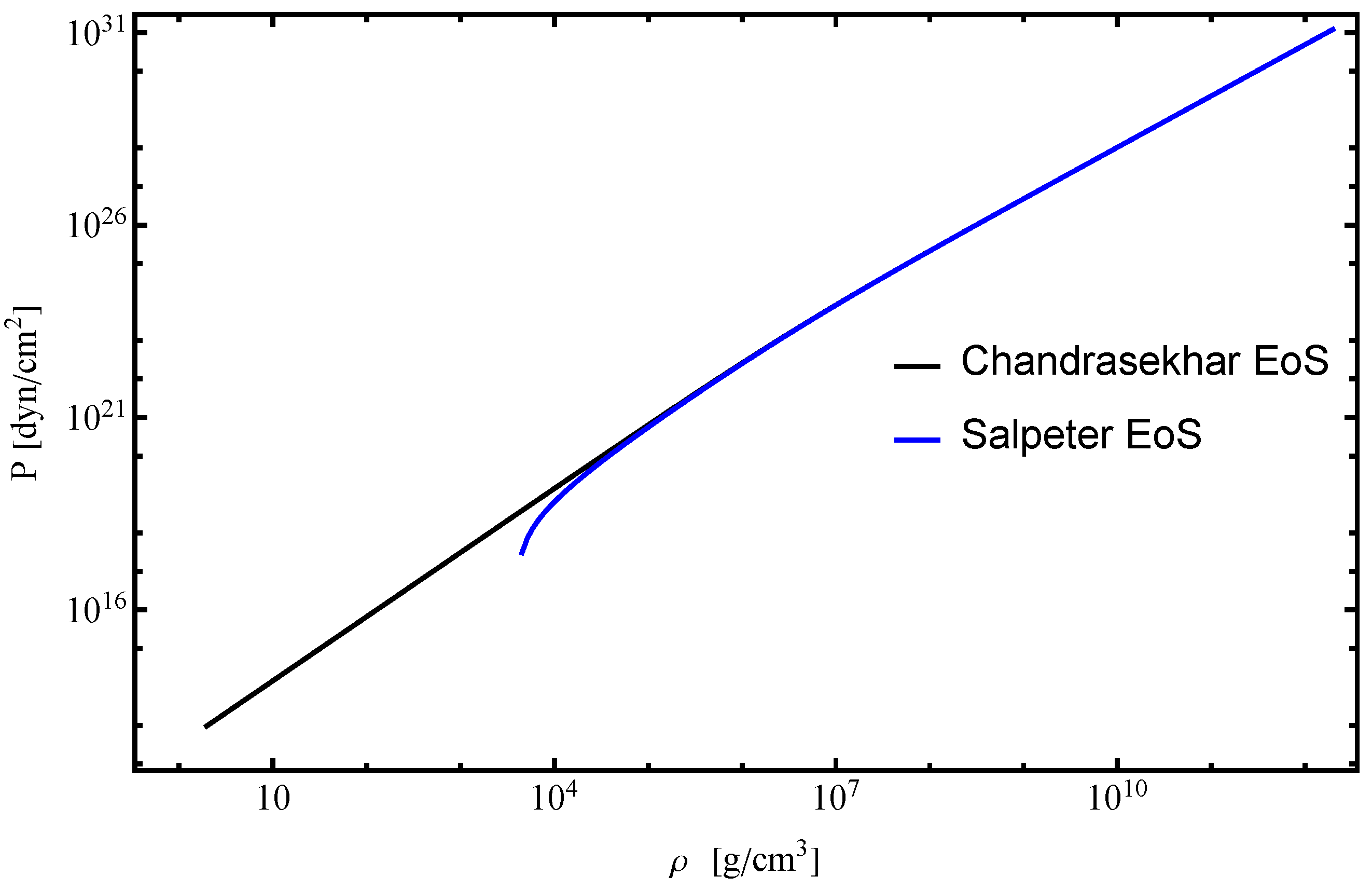
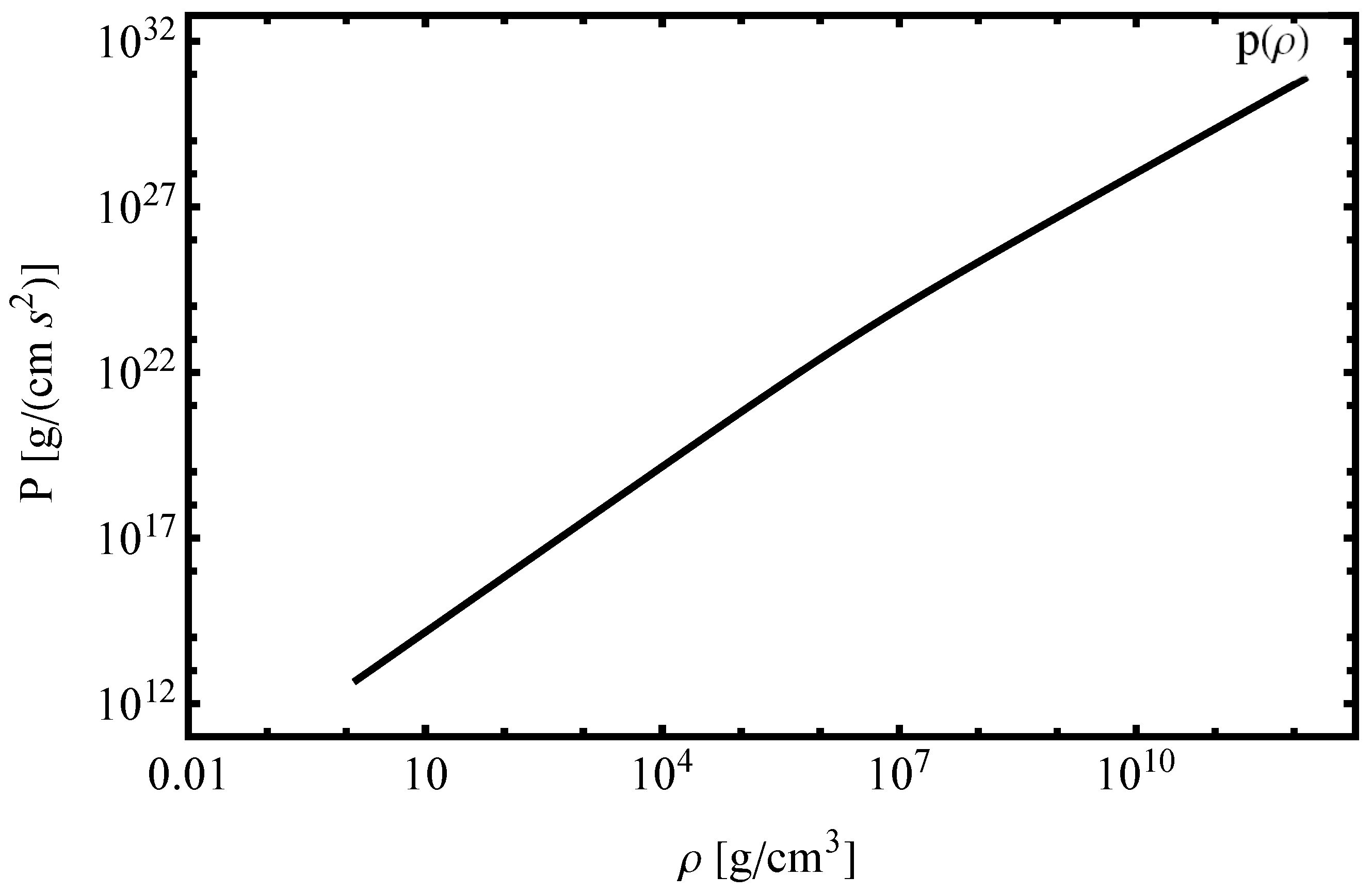
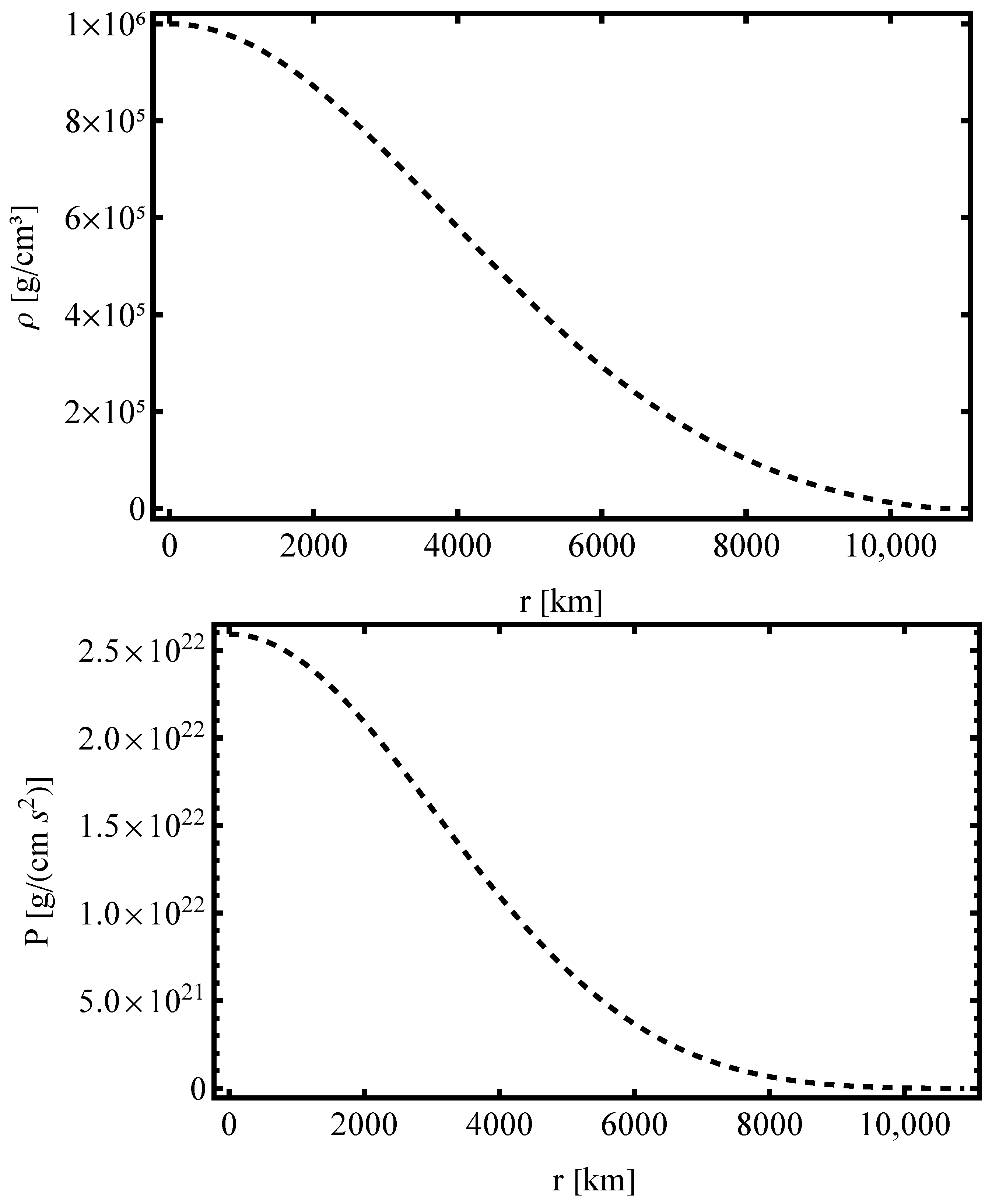
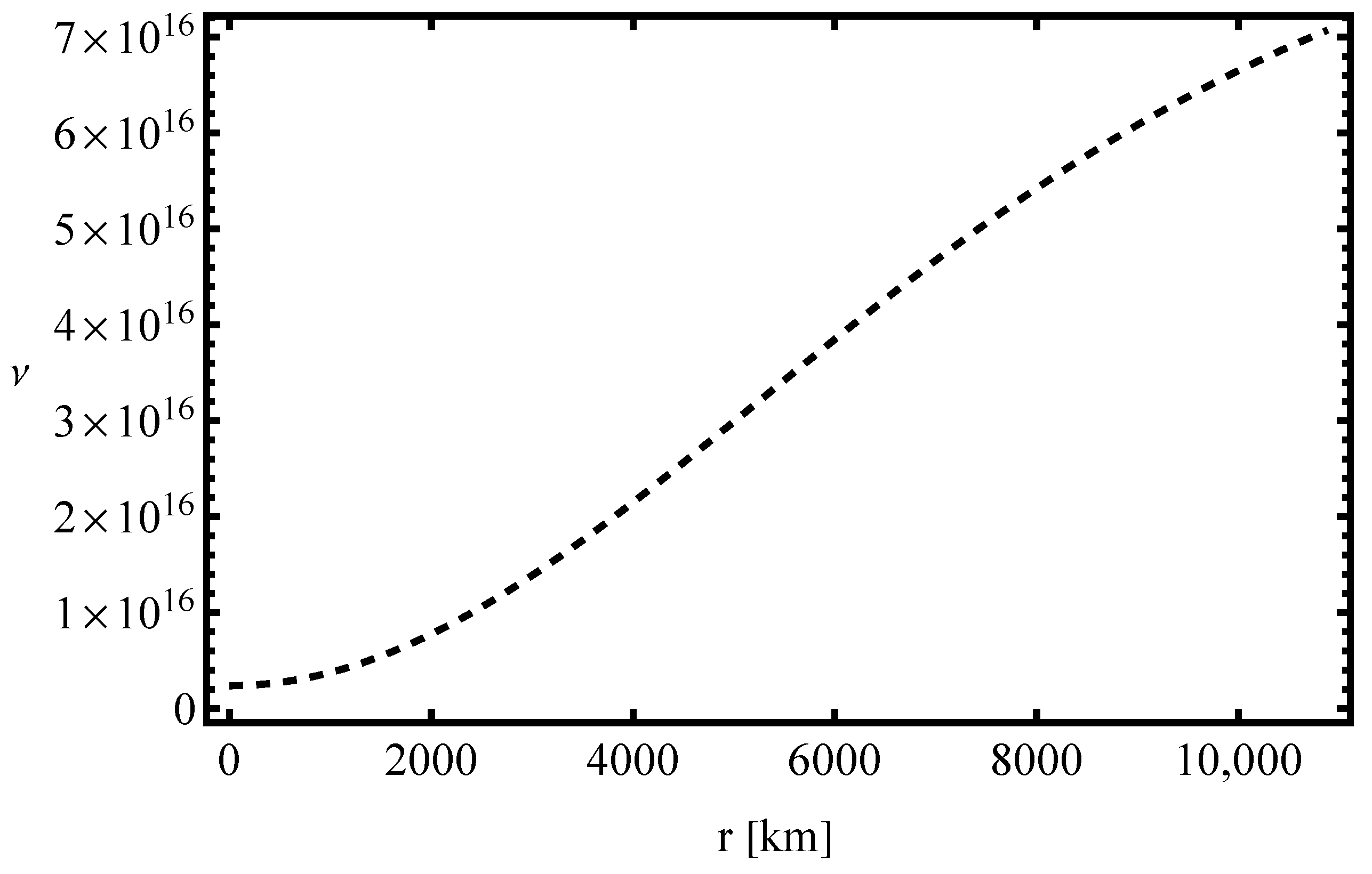

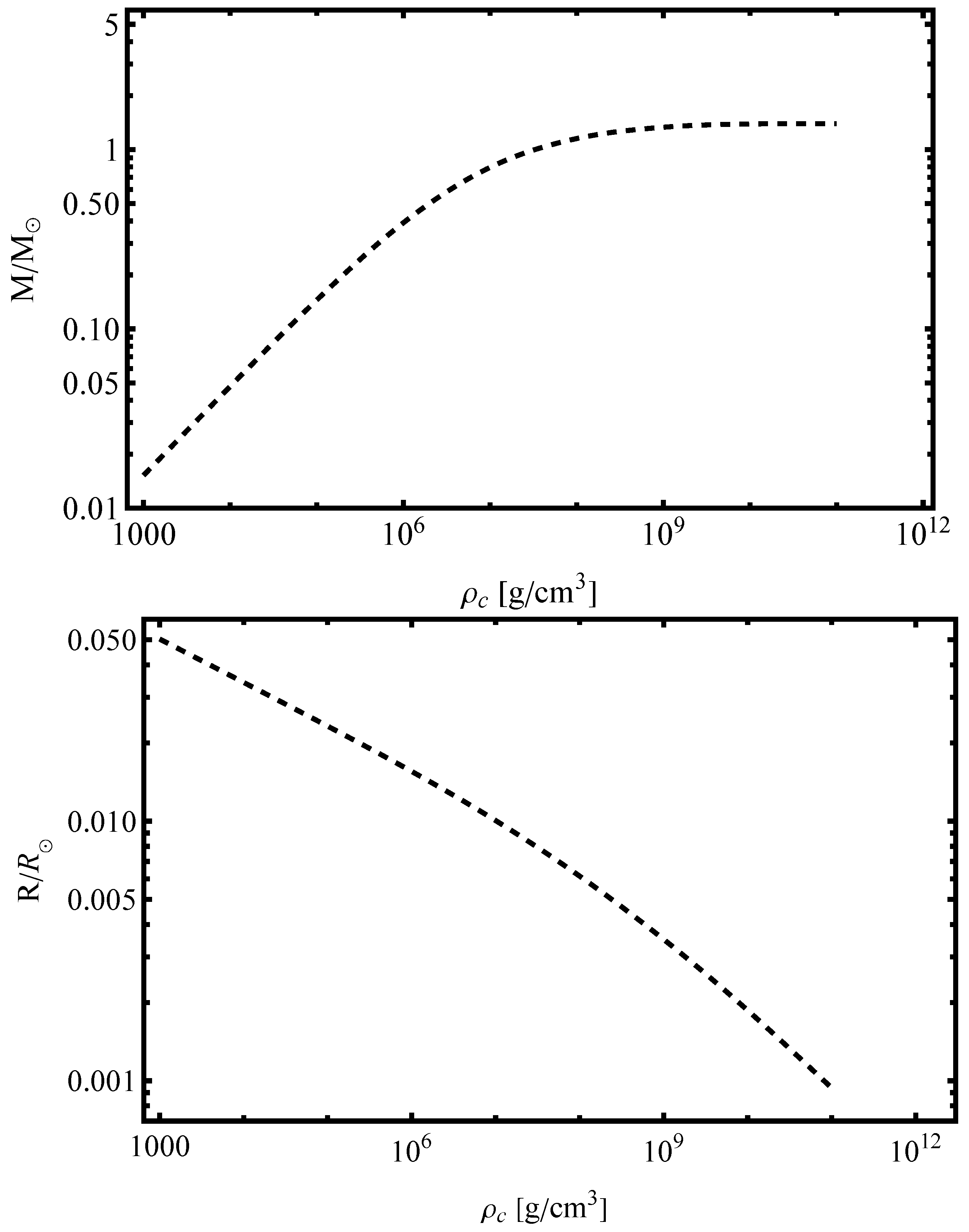
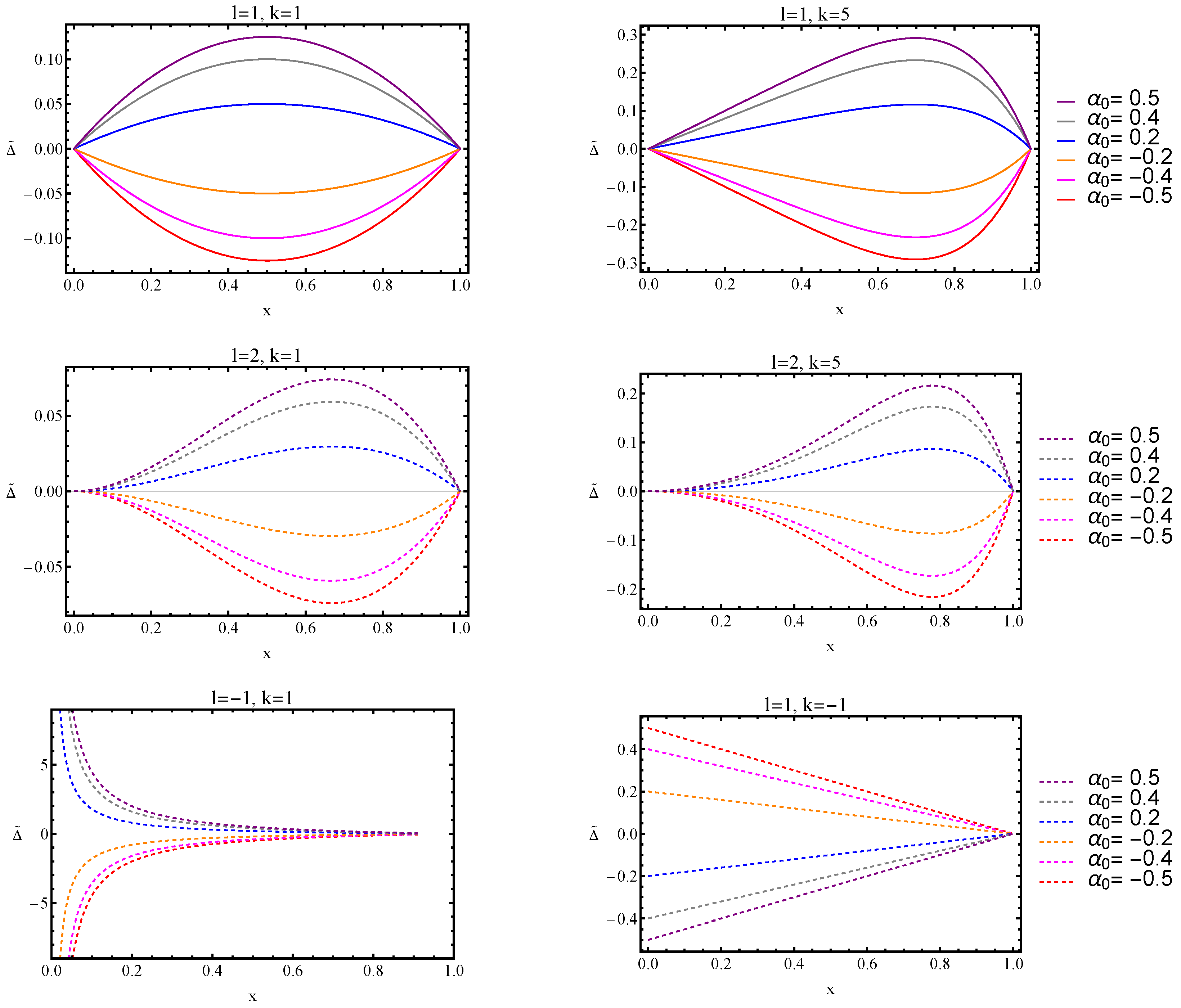
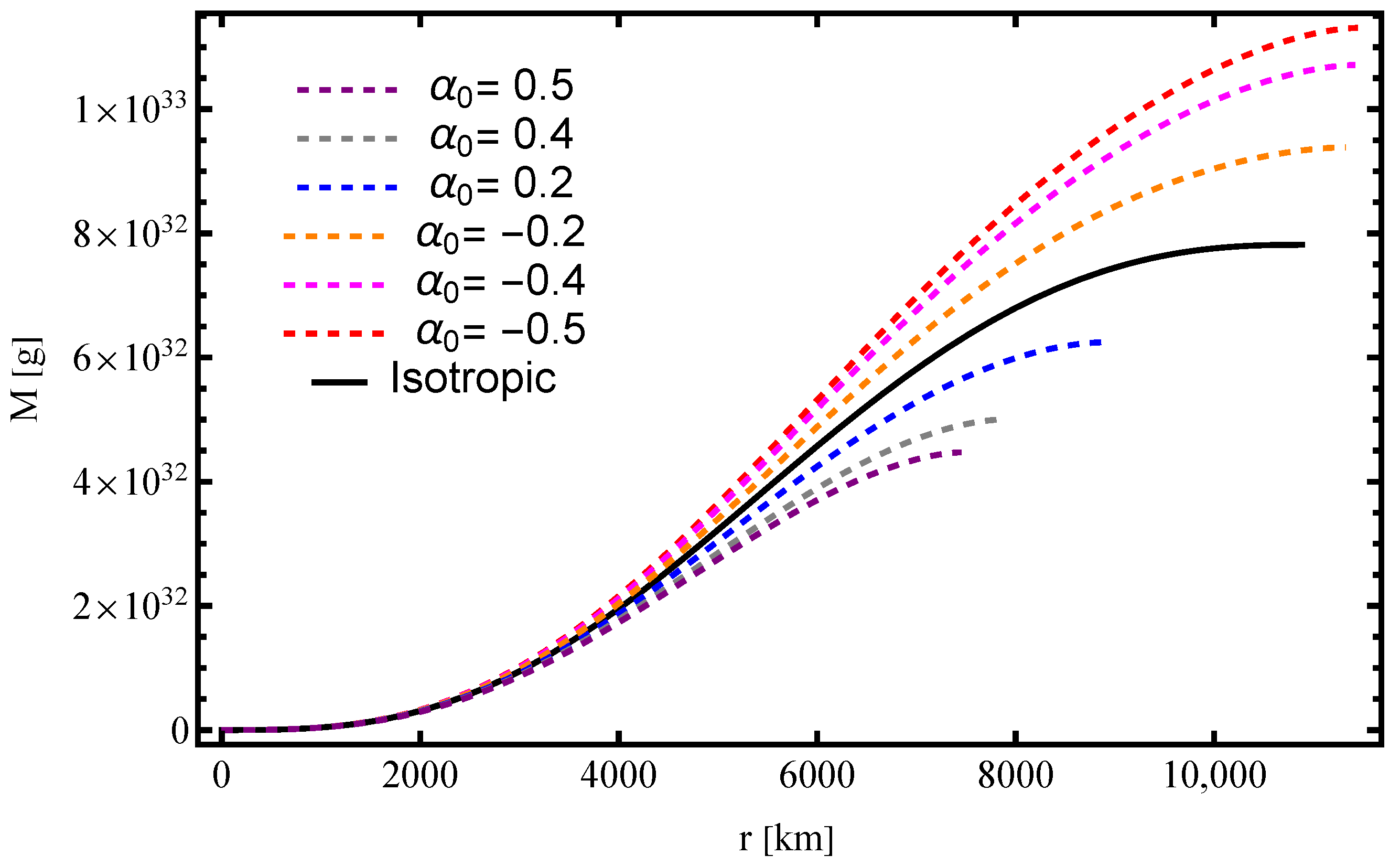

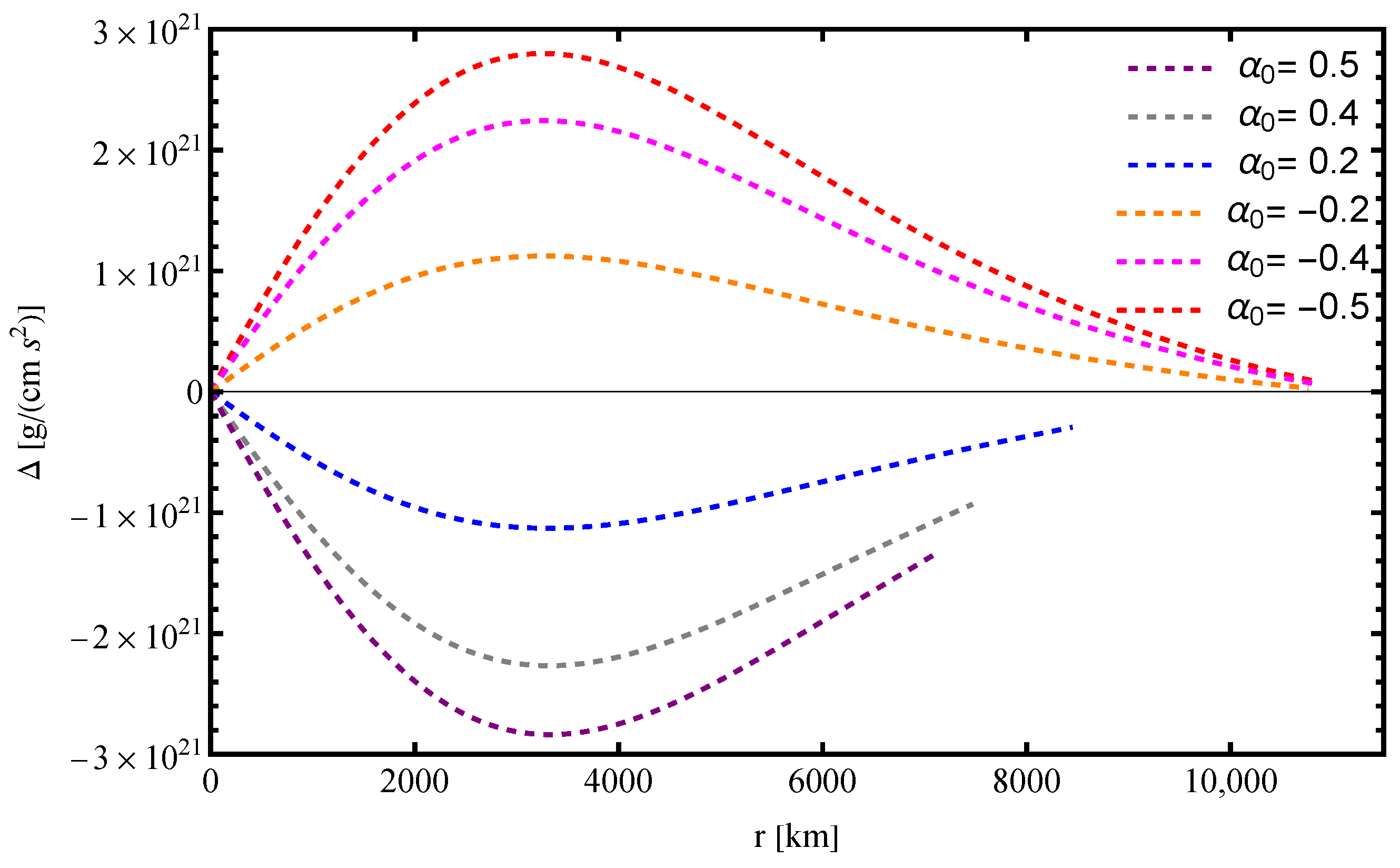
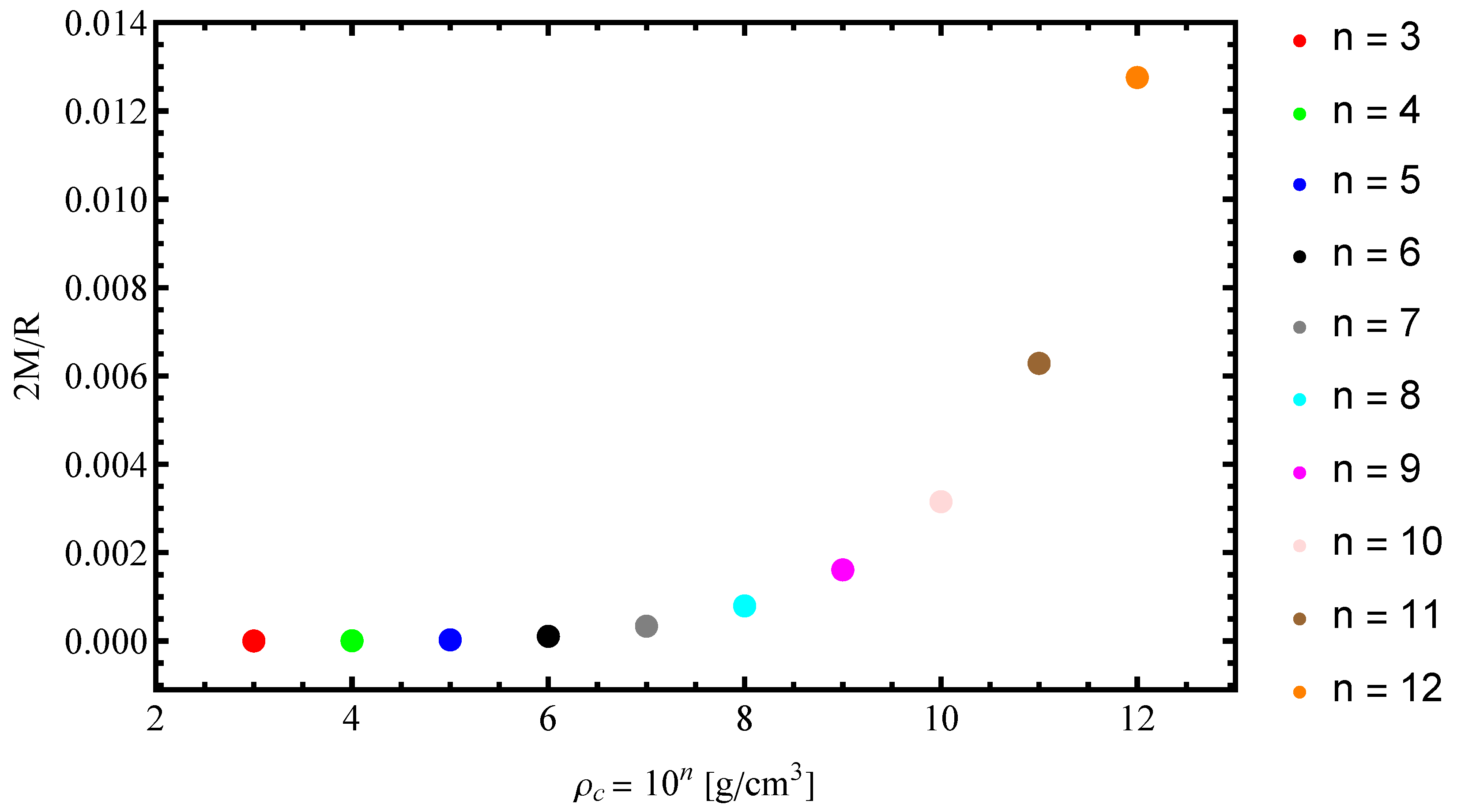
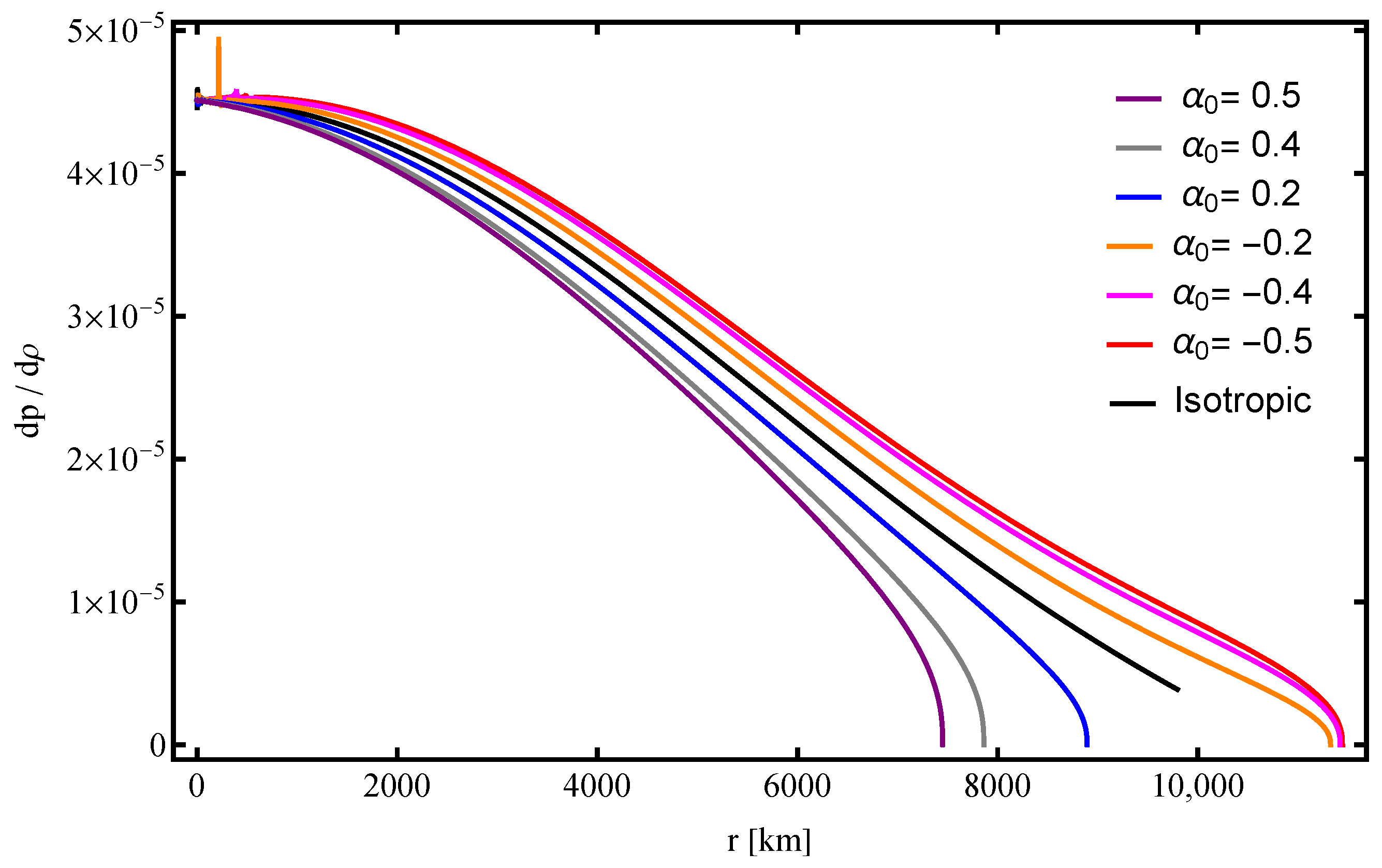
| Compactness | ||||
|---|---|---|---|---|
| 1.68987 | 0.66886 | 0.16762 | 0.83821 | |
| 1.68983 | 0.66887 | 0.16763 | 0.83825 | |
| 1.68780 | 0.66938 | 0.16796 | 0.83989 | |
| 1.64033 | 0.69283 | 0.17887 | 0.89448 | |
| 1.57242 | 0.90815 | 0.24459 | 1.22316 | |
| 1.56068 | 1.21976 | 0.33098 | 1.65533 | |
| 1.55824 | 1.38966 | 0.37767 | 1.88891 | |
| 1.55772 | 1.44456 | 0.39273 | 1.96421 | |
| 1.55770 | 1.44734 | 0.39349 | 1.96802 | |
| 1.55793 | 1.42172 | 0.38647 | 1.9329 |
| Compactness | ||||
|---|---|---|---|---|
| 1.5577 | 1.44734 | 0.39349 | 0.19680 | |
| 1.55577 | 1.41999 | 0.38653 | 0.19332 | |
| 1.55496 | 1.39829 | 0.38082 | 0.19047 | |
| 0 | 0.09385 | 1.39293 | 6.28533 | 3.15756 |
| 0.1 | 0.09384 | 1.39293 | 6.28600 | 3.15789 |
| 0.5 | 0.09382 | 1.39293 | 6.28724 | 3.15852 |
| 1 | 0.09381 | 1.39293 | 6.28832 | 3.15907 |
Disclaimer/Publisher’s Note: The statements, opinions and data contained in all publications are solely those of the individual author(s) and contributor(s) and not of MDPI and/or the editor(s). MDPI and/or the editor(s) disclaim responsibility for any injury to people or property resulting from any ideas, methods, instructions or products referred to in the content. |
© 2025 by the authors. Licensee MDPI, Basel, Switzerland. This article is an open access article distributed under the terms and conditions of the Creative Commons Attribution (CC BY) license (https://creativecommons.org/licenses/by/4.0/).
Share and Cite
Orazymbet, A.; Muratkhan, A.; Utepova, D.; Beissen, N.; Baimbetova, G.; Toktarbay, S. Numerical Solutions and Stability Analysis of White Dwarfs with a Generalized Anisotropic Factor. Galaxies 2025, 13, 69. https://doi.org/10.3390/galaxies13030069
Orazymbet A, Muratkhan A, Utepova D, Beissen N, Baimbetova G, Toktarbay S. Numerical Solutions and Stability Analysis of White Dwarfs with a Generalized Anisotropic Factor. Galaxies. 2025; 13(3):69. https://doi.org/10.3390/galaxies13030069
Chicago/Turabian StyleOrazymbet, Ayazhan, Aray Muratkhan, Daniya Utepova, Nurzada Beissen, Gulzada Baimbetova, and Saken Toktarbay. 2025. "Numerical Solutions and Stability Analysis of White Dwarfs with a Generalized Anisotropic Factor" Galaxies 13, no. 3: 69. https://doi.org/10.3390/galaxies13030069
APA StyleOrazymbet, A., Muratkhan, A., Utepova, D., Beissen, N., Baimbetova, G., & Toktarbay, S. (2025). Numerical Solutions and Stability Analysis of White Dwarfs with a Generalized Anisotropic Factor. Galaxies, 13(3), 69. https://doi.org/10.3390/galaxies13030069






